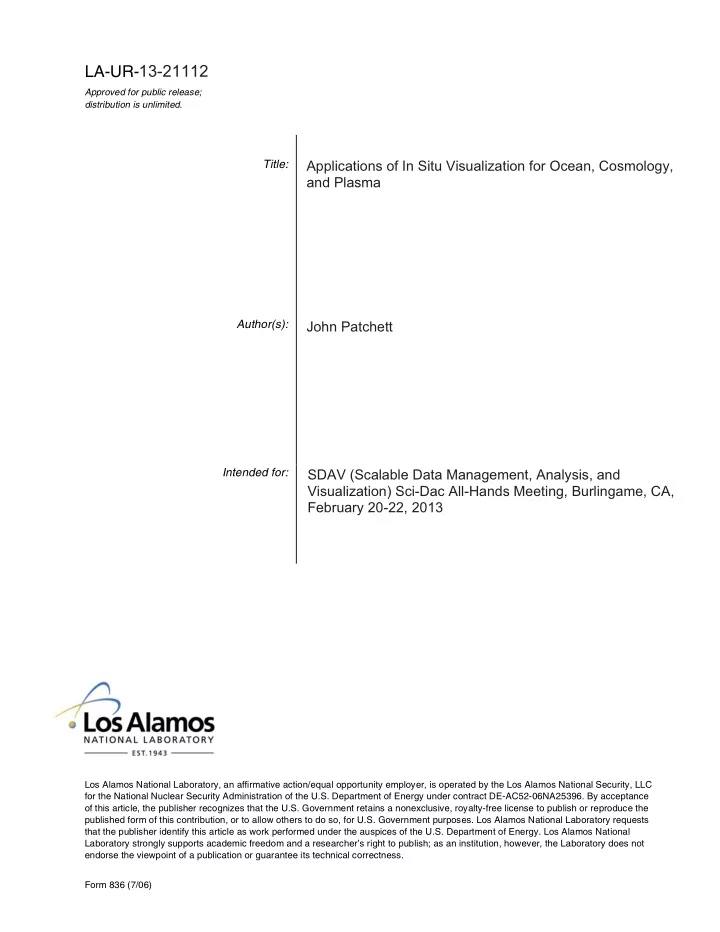

LA-UR- 13-21112 Approved for public release; distribution is unlimited. Title: Applications of In Situ Visualization for Ocean, Cosmology, and Plasma Author(s): John Patchett Intended for: SDAV (Scalable Data Management, Analysis, and Visualization) Sci-Dac All-Hands Meeting, Burlingame, CA, February 20-22, 2013 Los Alamos National Laboratory, an affirmative action/equal opportunity employer, is operated by the Los Alamos National Security, LLC for the National Nuclear Security Administration of the U.S. Department of Energy under contract DE-AC52-06NA25396. By acceptance of this article, the publisher recognizes that the U.S. Government retains a nonexclusive, royalty-free license to publish or reproduce the published form of this contribution, or to allow others to do so, for U.S. Government purposes. Los Alamos National Laboratory requests that the publisher identify this article as work performed under the auspices of the U.S. Department of Energy. Los Alamos National Laboratory strongly supports academic freedom and a researcher’s right to publish; as an institution, however, the Laboratory does not endorse the viewpoint of a publication or guarantee its technical correctness. Form 836 (7/06)
ABSTRACT This is a five minute or less talk for the Office of Science SDAV All Hands Meeting on 2/20/2013. It describes our work with three domains of science: ocean modeling (POP), cosmology(HACC), and plasma(VPIC). In particular it presents work that was directly related to in situ analysis and our future work with these models under SDAV. LA-UR-13-21112
APPLICATIONS OF IN SITU VISUALIZATION FOR OCEAN, COSMOLOGY, AND PLASMA John Patchett (LANL) SDAV All-Hands Meeting February 20-22, 2013 LA-UR-13-21112
In Situ for Ocean Compute 1/10º Global MOC Parallel Ocean Program (POP) 5 4 Meridional Overturning Seconds Circulation (MOC) 3 -text book diagnostic not 2 scaled for high resolution 1 -used to understand ocean 0 16 32 64 128 256 512 1024 circulation Number Processors Designed and implemented a parallel MOC ParaView-Catalyst -Collaboration with Kitware -In memory POP adaptor -MOC to be converted into a ParaView filter LA-UR-13-21112
In Situ for Cosmology Hardware/Hybrid Accelerated Cosmology Code (HACC) -Cosmological Simulation runs big Halos -Areas of higher density -Important cosmological features -Original slab based method of halo finding not scaling Parallel Halo Finding solution -friends of friends algorithm with range finding data structures -Started as post processing then went native in situ Improved memory usage for Halo Finding -15-32 bit values/particle reduced to 6-32 bit values/particle “The Outer Rim” simulation Full Restarts: 100TB/time step Particles Only: 40TB/time step Halo Catalogs: < 10TB total Store initial conditions + halo features, re-compute if necessary Example 2012: 15-20 hours on 65k cores – no restarts written – Halo Catalogs less taxing on I/O LA-UR-13-21112
In Situ for Plasma VPIC (Vector Particle in Cell) Extremely large output files -Large in quantity and count -Difficult for end user to do basic visualization Designed and Developed parallel VPIC reader for post processing -enabled motivated user to work on different supercomputers using Surface line integral convolution visualization to investigate generated in VPIC using ParaView- Catalyst simulation outputs between runs Actively developing in situ capability Hard Coded Operators: Surface Line Integral Convolution, slice, contour In Situ + PISTON Contour Operator Contours made using 2D slices produced PISTON in-situ in-situ with VPIC LA-UR-13-21112
Conclusion We continue to work with Ocean, Cosmology, and Plasma scientists producing solutions to their large scale problems We find apps that run big with an associated analysis task that isn’t running big We develop and implement parallel algorithms as solutions We typically provide a number of interfaces to the solutions We enable simulations to run bigger and do more complex analysis LA-UR-13-21112
Recommend
More recommend